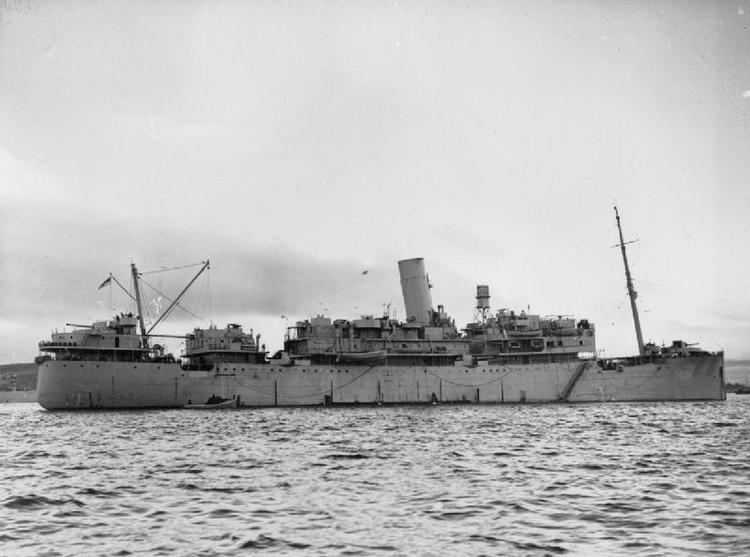 | ||
HMS Cheshire (F18), was a ship of the Royal Navy, named after the English county of Cheshire. Previously a cruise ship, she served as an armed merchant cruiser acting as convoy escort and troopship in World War II.
Contents
Cheshire proved doughty in her military role:
She was torpedoed twice by U-boats but survived each and returned to service after extensive repairs.
She also survived a U-boat attack on a small convoy of troopships transiting the English Channel from Southampton, England to Cherbourg, France, containing just herself and SS Leopoldville, with over 800 lives lost when Leopoldville went down.
During Cheshire's very next run, transporting U.S. troops from Southampton to Le Havre between 28 and 31 December 1944, another troop transport in convoy on the same route, SS Empire Javelin, was lost to a possible mine on 28 December.
Cheshire was used as a repatriation ship at war's end in 1945, and was returned to her owner in 1948. She was broken up at Newport in July 1957.
History
HMS Cheshire was launched in 1927 by Fairfield Shipbuilding & Engineering Co Ltd, Govan, Glasgow, 10,552 tons gwt. She was completed in July that year by Bibby Brothers & Co, Liverpool as the motor passenger ship Cheshire. On 29 August 1939, she was requisitioned by the Admiralty and converted to the armed merchant cruiser HMS Cheshire (F 18).
Captained by M.R. Bernard, Rtd, RN, she was struck by one torpedo from U-137 on 14 October 1940, northwest of Ireland (55°13′N 13°02′W). A total of 220 crew members were taken off by the Canadian destroyer Skeena. Cheshire was towed to Belfast Lough and beached. Later she was taken to Liverpool for repairs lasting six months.
Back in action, she was torpedoed again several months later at 41°30′N 19°49′W by U-214, Kapitänleutnant Günther Reeder in command, which fired four warheads at the convoy SL-118 at 18:52 on 18 August 1942. Detonations were heard 2 minutes 27 seconds, 3 minutes 10 seconds, 4 minutes 31 seconds and 4 minutes 37 seconds later, along with the sounds of three ships breaking up. U-214 claimed the sinking of four ships totaling 20,000 grt. In reality one torpedo had damaged Cheshire, another sank Hatarana and two torpedoes sank Balingkar.
She also survived a U-boat attack on a small convoy of troopships transiting the English Channel from Southampton, England to Cherbourg, France, containing just herself and SS Leopoldville. While protected by an escort of four destroyers steaming in a diamond-shaped screen surrounding the transports, Leopoldville was torpedoed and sunk by on 24 December 1944, by U-486. Loss of life in a confused rescue effort and cold Atlantic was heavy, with over 800 perishing, 763 of them U.S. soldiers headed for deployment in the Battle of the Bulge.
During Cheshire's very next run, delivering U.S. troops to Le Havre from Southampton between 28 and 31 December 1944, a troop transport in convoy on the same route, SS Empire Javelin, was lost to possible mine on 28 December. On 9 June 1943, she was returned to her owner and used by the Ministry of War Transport as troop transport.
Units transported
Units transported during World War II by Sea Owl included:
Post-war
Cheshire was used as a repatriation ship in 1945 and returned to the owner on 5 October 1948. She was broken up at Newport in July 1957.
